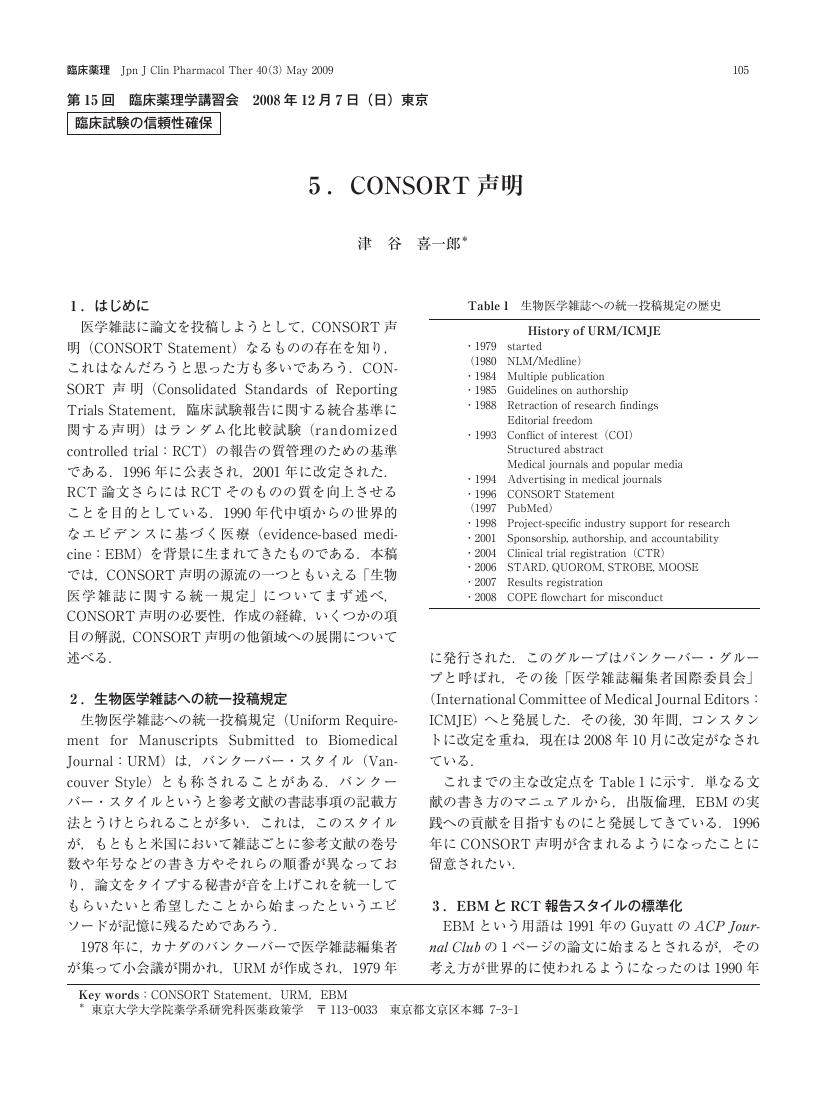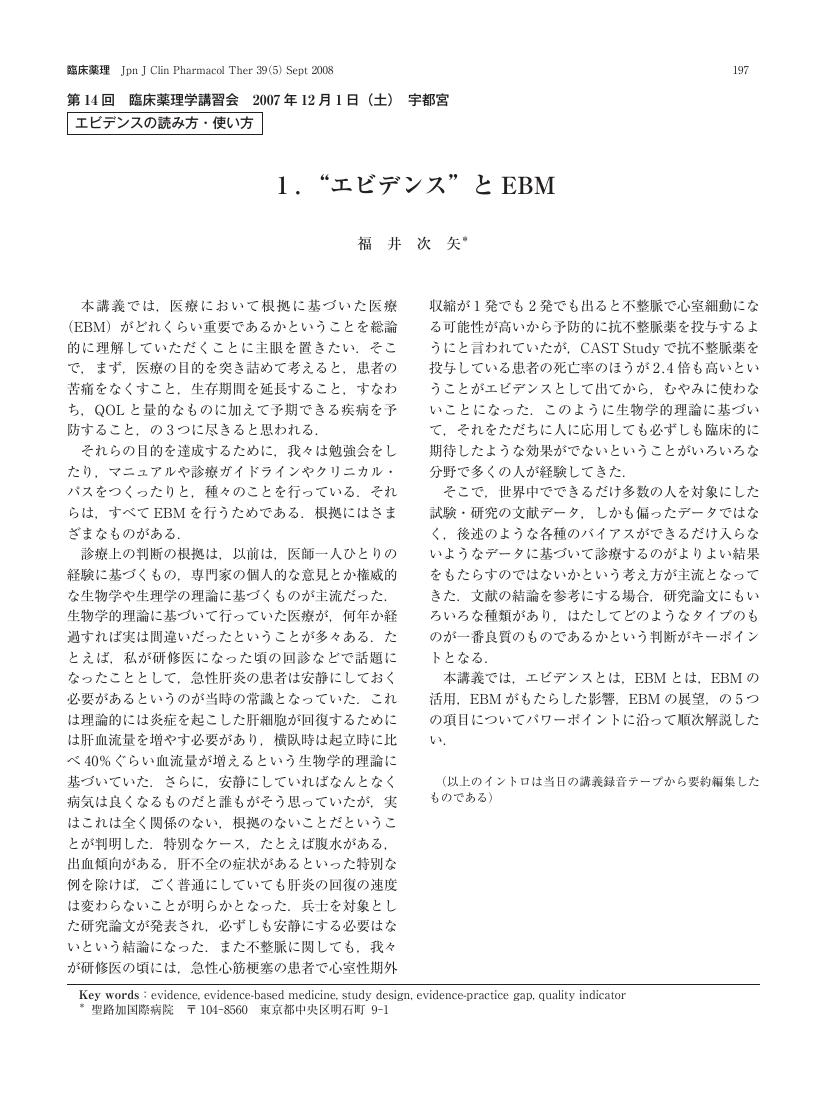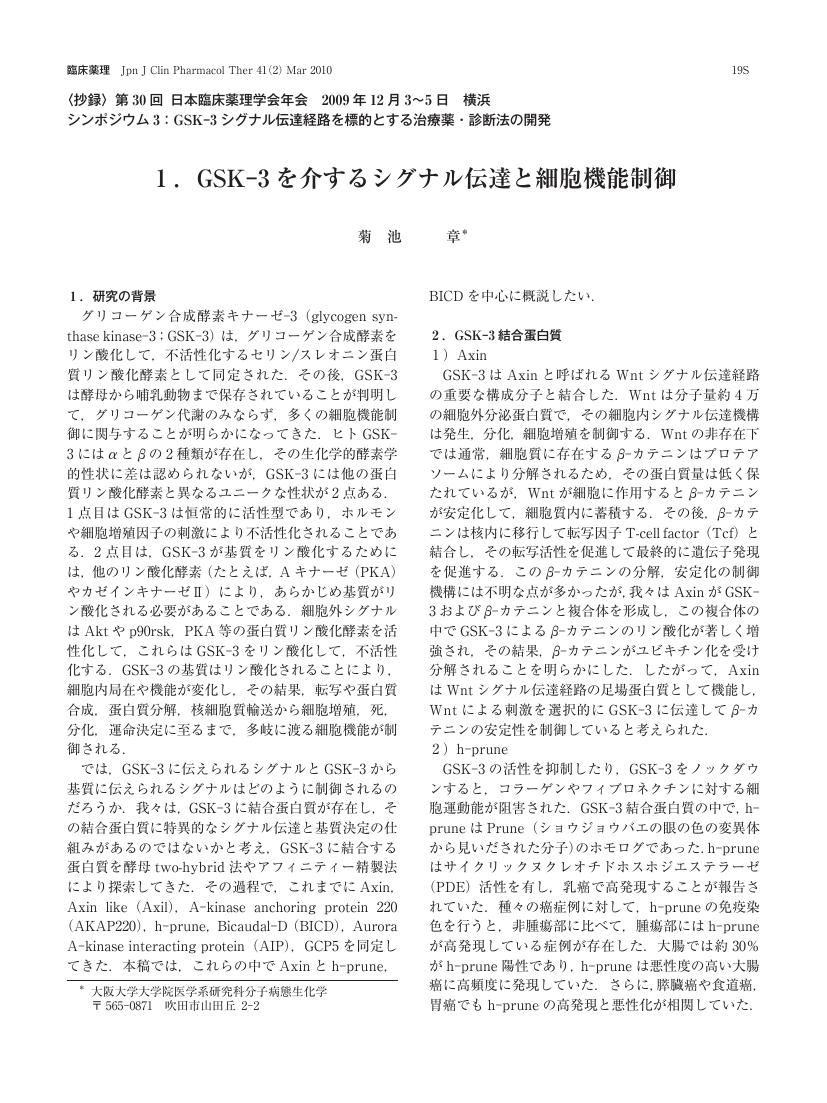124 0 0 0 OA ワクチンの医療経済評価
- 著者
- 赤沢 学
- 出版者
- 一般社団法人 日本臨床薬理学会
- 雑誌
- 臨床薬理 (ISSN:03881601)
- 巻号頁・発行日
- vol.41, no.5, pp.245-252, 2010 (Released:2010-11-25)
- 参考文献数
- 18
- 被引用文献数
- 2 1
A number of new vaccines for preventable diseases such as meningitis and cervical cancer are getting available for Japanese children. However, those vaccines are categorized as voluntary vaccination and their costs should be paid by recipients. Therefore, high cost is a barrier for access to the preventive care. In addition, subsidiary by local governments causes their regional disparities. On the other hand, the Advisory Committee on Immunization Practices (ACIP) in the United States recognizes importance of economic analyses in establishing policy for addition of new vaccines to routine immunization schedules. The ACIP publishes guidance for health economic studies to ensure that high quality economic data are presented in a standard format. In this study, a critical review of economic analyses for childhood vaccine programs in Japan was conducted. Six original studies that included varicella, mumps, Hib (haemophilus influenza type B), pneumococcal disease and human papillomavirus vaccines were identified by a systematic literature review. The results of all studies suggested that these new vaccines should be included to routine immunization schedules because expected benefits would outweigh additional costs of vaccines. However, according to the check lists recommended by ACIP guideline, these studies utilized various sources of cost information and calculated opportunity costs differently. Some studies did not consider discounting of future costs. Therefore, direct comparisons between studies were very difficult. Economic analyses to evaluate the priority of vaccine programs should follow a standard method to increase comparability and quality of studies.
60 0 0 0 OA 5.CONSORT声明
- 著者
- 津谷 喜一郎
- 出版者
- 一般社団法人 日本臨床薬理学会
- 雑誌
- 臨床薬理 (ISSN:03881601)
- 巻号頁・発行日
- vol.40, no.3, pp.105-110, 2009 (Released:2009-08-12)
- 参考文献数
- 7
24 0 0 0 OA 4.JIKEI HEART研究
- 著者
- 三輪 宜一
- 出版者
- 一般社団法人 日本臨床薬理学会
- 雑誌
- 臨床薬理 (ISSN:03881601)
- 巻号頁・発行日
- vol.39, no.5, pp.157-161, 2008 (Released:2009-02-05)
- 参考文献数
- 18
18 0 0 0 OA TGN1412事件
- 著者
- 熊谷 雄治
- 出版者
- 一般社団法人 日本臨床薬理学会
- 雑誌
- 臨床薬理 (ISSN:03881601)
- 巻号頁・発行日
- vol.37, no.6, pp.367-368, 2006-11-30 (Released:2010-06-28)
- 参考文献数
- 6
- 被引用文献数
- 1
14 0 0 0 OA 臨床第1相試験におけるプラセボ投与時の自覚症状発現に関する検討
- 著者
- 有田 悦子 熊谷 雄治 横田 慎一
- 出版者
- 一般社団法人 日本臨床薬理学会
- 雑誌
- 臨床薬理 (ISSN:03881601)
- 巻号頁・発行日
- vol.31, no.1, pp.165-166, 2000-01-31 (Released:2010-06-28)
- 参考文献数
- 3
- 被引用文献数
- 1
13 0 0 0 OA 1.“エビデンス”とEBM
- 著者
- 福井 次矢
- 出版者
- 一般社団法人 日本臨床薬理学会
- 雑誌
- 臨床薬理 (ISSN:03881601)
- 巻号頁・発行日
- vol.39, no.5, pp.197-204, 2008 (Released:2009-02-05)
11 0 0 0 OA シンナーその他揮発性物質吸引乱用 シンナー遊びを中心に
- 著者
- 田所 作太郎
- 出版者
- 一般社団法人 日本臨床薬理学会
- 雑誌
- 臨床薬理 (ISSN:03881601)
- 巻号頁・発行日
- vol.8, no.3, pp.347-355, 1977-09-30 (Released:2010-06-28)
- 参考文献数
- 54
- 被引用文献数
- 1 1
8 0 0 0 OA 1.GSK-3を介するシグナル伝達と細胞機能制御
- 著者
- 菊池 章
- 出版者
- 一般社団法人 日本臨床薬理学会
- 雑誌
- 臨床薬理 (ISSN:03881601)
- 巻号頁・発行日
- vol.41, no.2, pp.19S-20S, 2010 (Released:2010-06-22)
7 0 0 0 OA ヒト初回投与試験 (FIH 試験) を含む早期臨床試験のチェックリスト
- 著者
- 日本臨床薬理学会 FIH 試験チェックリスト作成タスクフォース
- 出版者
- 一般社団法人 日本臨床薬理学会
- 雑誌
- 臨床薬理 (ISSN:03881601)
- 巻号頁・発行日
- vol.49, no.5, pp.183-194, 2018-09-30 (Released:2018-10-27)
- 参考文献数
- 7
- 被引用文献数
- 2 2
6 0 0 0 OA 4.医薬品の毒性評価の考え方
- 著者
- 小野寺 博志
- 出版者
- 一般社団法人 日本臨床薬理学会
- 雑誌
- 臨床薬理 (ISSN:03881601)
- 巻号頁・発行日
- vol.41, no.4, pp.147-152, 2010 (Released:2010-10-08)
- 参考文献数
- 18
Drugs have to be evaluated from a different viewpoint from other toxic substances such as natural toxins, environment substances and chemicals. Toxicological evaluations are also important to clarify the benefits and risks of pharmaceuticals to humans. Many of the toxicology studies are conducted according to guidelines. The type and timing of toxicology studies have been harmonized internationally. Recently, the ICH guidelines have been revised in light of technological advances and reduction of animal usage in accordance with the 3R (reduce/refine/replace) principle. The results of toxicology studies must always be evaluated based on extrapolation to humans. The goal of regulatory science is to predict a risk based on the latest information and evaluate safety. Even if the toxicological findings are similar, the toxicological acceptability assessment is not always the same. It is important that the toxicology for pharmaceutical products is evaluated on a case-by-case basis.
6 0 0 0 OA RifampicinのPharmacokineticsに対する食事の影響
- 著者
- 西村 富啓 河野 晴一 倉島 篤行 久保 博昭 小池 勇一
- 出版者
- The Japanese Society of Clinical Pharmacology and Therapeutics
- 雑誌
- 臨床薬理 (ISSN:03881601)
- 巻号頁・発行日
- vol.37, no.6, pp.353-357, 2006-11-30 (Released:2010-06-28)
- 参考文献数
- 23
- 被引用文献数
- 1 1
Rifampicin (RFP) is one of the first-line drugs in the treatment of tuberculosis. Worldwide, the recommended administration of RFP is before breakfast, however it is commonly administered after the meal in Japan. It is known that the absorption of RFP is affected by a meal. Therefore, the effects of meal on the pharmacokinetics of rifampicin were studied in patients with tuberculosis.Ten male patients participated in this study. Five of the ten patients were given three capsules (450mg of RFP) 30 minutes before breakfast. The other five patients were given the same dose of RFP 30 minutes after breakfast. The mean age and weight were 54.6±3.3 years and 53.9±2.7kg in the group before meal and in the after the meal group, 49.8±8.4 years and 53.8±5.0kg, respectively. All the data were expressed as mean±S.D. Blood samples were taken at 0, 2, 4 and 6 hours after capsule administration. RFP concentra tions in serum were analyzed by reversed-phase high performance liquid chromatography and the relevant pharmacokinetic parameters were calculated. Group means were compared by use of nonparametric statis tics.In the group before meal, the peak concentration (Cmax) was significantly higher than that in the group after meal (9.32±0.88μg/mL versus 5.76 ± 1.04 μg/mL, p<0.05) and the AUC was also significantly higher than that in the group after meal (35.83±3.29μg/hr/mL versus 18.63±4.35μg/hr/mL, p<0.05). These results suggest that RFP should be taken 30 minutes before the meal.
6 0 0 0 OA 3. 片頭痛
- 著者
- 中島 健二 竹島 多賀夫
- 出版者
- 一般社団法人 日本臨床薬理学会
- 雑誌
- 臨床薬理 (ISSN:03881601)
- 巻号頁・発行日
- vol.36, no.6, pp.277-283, 2005-11-30 (Released:2010-06-28)
- 参考文献数
- 24
6 0 0 0 OA 非線形混合効果モデルにおける線形一次近似の統計学的問題点
- 著者
- 矢船 明史 竹内 正弘 成川 衛
- 出版者
- 日本臨床薬理学会
- 雑誌
- 臨床薬理 (ISSN:03881601)
- 巻号頁・発行日
- vol.31, no.6, pp.705-713, 2000-11-30 (Released:2010-06-28)
- 参考文献数
- 20
- 被引用文献数
- 1
Since nonlinear mixed effects model is statistically quite complicated, it is not possible to obtain the analytical forms of the marginal mean and its corresponding covariance matrix for observations. To circumvent this issue, a first-order Taylor series expansion is generally employed to approximate a nonlinear model with a linear form additive in inter-subject random effects. This linear approximation is based on the assumption that the parameter variation among subjects is negligible, which is quite hard to satisfy in actual clinical data analyses. Consequently, the linear approximation probably leads to inconsistent estimators. This paper describes the statistical issues regarding the first-order linear approximation in nonlinear mixed effects models.
5 0 0 0 OA 催眠薬
- 著者
- 加藤 信
- 出版者
- 一般社団法人 日本臨床薬理学会
- 雑誌
- 臨床薬理 (ISSN:03881601)
- 巻号頁・発行日
- vol.8, no.3, pp.339-345, 1977-09-30 (Released:2010-06-28)
- 参考文献数
- 12
5 0 0 0 OA 6.臨床試験登録の必要性,現状とその展望
- 著者
- 西内 啓 木内 貴弘
- 出版者
- 一般社団法人 日本臨床薬理学会
- 雑誌
- 臨床薬理 (ISSN:03881601)
- 巻号頁・発行日
- vol.40, no.3, pp.111-117, 2009 (Released:2009-08-12)
- 参考文献数
- 11
5 0 0 0 薬物依存関係用語の問題点
- 著者
- 柳田 知司
- 出版者
- The Japanese Society of Clinical Pharmacology and Therapeutics
- 雑誌
- 臨床薬理 (ISSN:03881601)
- 巻号頁・発行日
- vol.6, no.4, pp.347-350, 1975
4 0 0 0 OA 5. 薬効と薬物動態の個人差・人種差のポイント
- 著者
- 安原 一
- 出版者
- 一般社団法人 日本臨床薬理学会
- 雑誌
- 臨床薬理 (ISSN:03881601)
- 巻号頁・発行日
- vol.26, no.2, pp.625-630, 1995-06-30 (Released:2010-06-28)
- 参考文献数
- 11
- 被引用文献数
- 1
4 0 0 0 OA カルビドパ合剤とベンセラジド合剤の違いによるパーキンソン病患者L―ドパ血中濃度の変化
- 著者
- 永井 将弘 張 捷 中塚 晶子 矢部 勇人 野元 正弘
- 出版者
- 一般社団法人 日本臨床薬理学会
- 雑誌
- 臨床薬理 (ISSN:03881601)
- 巻号頁・発行日
- vol.35, no.1, pp.231S, 2004-01-31 (Released:2010-06-28)
- 参考文献数
- 1
4 0 0 0 OA シリーズ[1] こんな患者ならどうする?
- 著者
- 三輪 亮寿
- 出版者
- 一般社団法人 日本臨床薬理学会
- 雑誌
- 臨床薬理 (ISSN:03881601)
- 巻号頁・発行日
- vol.40, no.5, pp.247-250, 2009 (Released:2009-11-25)
4 0 0 0 OA 1. 肝疾患患者の薬物療法
- 著者
- 大西 明弘
- 出版者
- 一般社団法人 日本臨床薬理学会
- 雑誌
- 臨床薬理 (ISSN:03881601)
- 巻号頁・発行日
- vol.36, no.5, pp.221-225, 2005-09-30 (Released:2010-06-28)
- 参考文献数
- 15














